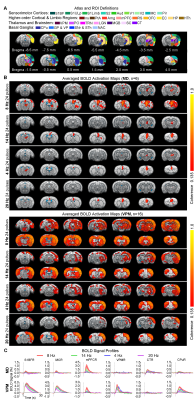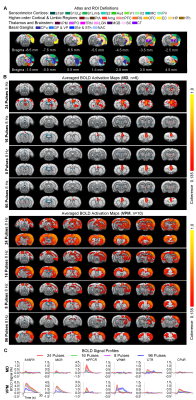Xunda Wang1,2, Alex T. L. Leong1,2, and Ed X. Wu1,2
1Laboratory of Biomedical Imaging and Signal Processing, The University of Hong Kong, Hong Kong SAR, China, 2Department of Electrical and Electronic Engineering, The University of Hong Kong, Hong Kong SAR, China
1Laboratory of Biomedical Imaging and Signal Processing, The University of Hong Kong, Hong Kong SAR, China, 2Department of Electrical and Electronic Engineering, The University of Hong Kong, Hong Kong SAR, China
Our optogenetic fMRI work provides direct evidence for
the first time demonstrating that limbic and sensory thalamically-evoked
spindle-like activities exhibit distinct brain-wide targets but similar
temporal-characteristics dependent cross-modal recruitment properties.

Brain-wide BOLD activations upon optogenetic
stimulation of MD versus VPM at different frequencies. (A)
Illustration of atlas-based ROI definitions in the sensorimotor cortices,
higher-order cortical and limbic regions, thalamus and brainstem, and basal
ganglia. (B) BOLD activation
maps upon optogenetic stimulation of MD and VPM at different frequencies
(Bonferroni-corrected p<0.001). MD and VPM stimulation recruited distinct
brain-wide targets, but both evoked brain-wide cross-modal BOLD activations at 8Hz.
(C) BOLD profiles extracted from atlas-based ROIs.

Brain-wide BOLD activations upon 8Hz optogenetic stimulation of MD versus
VPM at different number of pulses. (A) Atlas-based ROI definitions in the
sensorimotor cortices, higher-order cortical and limbic regions, thalamus and
brainstem, and basal ganglia. (B) BOLD activation maps upon 8Hz stimulation of MD
and VPM at different number of pulses (Bonferroni-corrected p<0.001). MD and
VPM stimulations showed similar decreases of brain-wide cross-modal BOLD
activations when varying the number of pulses from 24 to 16/8/96. (C) BOLD
profiles extracted from atlas-based ROIs.